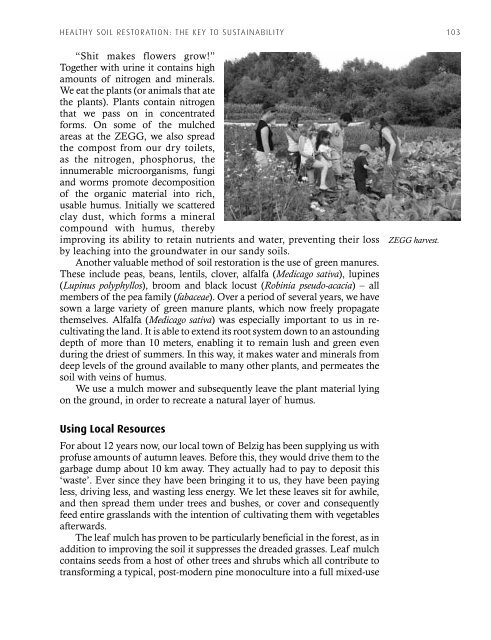Designing Ecological Habitats - Gaia Education
Designing Ecological Habitats - Gaia Education
Designing Ecological Habitats - Gaia Education
Create successful ePaper yourself
Turn your PDF publications into a flip-book with our unique Google optimized e-Paper software.
HealtHy soil restoration: tHe key to sustainability 103<br />
“Shit makes flowers grow!”<br />
Together with urine it contains high<br />
amounts of nitrogen and minerals.<br />
We eat the plants (or animals that ate<br />
the plants). Plants contain nitrogen<br />
that we pass on in concentrated<br />
forms. On some of the mulched<br />
areas at the ZEGG, we also spread<br />
the compost from our dry toilets,<br />
as the nitrogen, phosphorus, the<br />
innumerable microorganisms, fungi<br />
and worms promote decomposition<br />
of the organic material into rich,<br />
usable humus. Initially we scattered<br />
clay dust, which forms a mineral<br />
compound with humus, thereby<br />
improving its ability to retain nutrients and water, preventing their loss<br />
by leaching into the groundwater in our sandy soils.<br />
Another valuable method of soil restoration is the use of green manures.<br />
These include peas, beans, lentils, clover, alfalfa (Medicago sativa), lupines<br />
(Lupinus polyphyllos), broom and black locust (Robinia pseudo-acacia) – all<br />
members of the pea family (fabaceae). Over a period of several years, we have<br />
sown a large variety of green manure plants, which now freely propagate<br />
themselves. Alfalfa (Medicago sativa) was especially important to us in recultivating<br />
the land. It is able to extend its root system down to an astounding<br />
depth of more than 10 meters, enabling it to remain lush and green even<br />
during the driest of summers. In this way, it makes water and minerals from<br />
deep levels of the ground available to many other plants, and permeates the<br />
soil with veins of humus.<br />
We use a mulch mower and subsequently leave the plant material lying<br />
on the ground, in order to recreate a natural layer of humus.<br />
using Local Resources<br />
For about 12 years now, our local town of Belzig has been supplying us with<br />
profuse amounts of autumn leaves. Before this, they would drive them to the<br />
garbage dump about 10 km away. They actually had to pay to deposit this<br />
‘waste’. Ever since they have been bringing it to us, they have been paying<br />
less, driving less, and wasting less energy. We let these leaves sit for awhile,<br />
and then spread them under trees and bushes, or cover and consequently<br />
feed entire grasslands with the intention of cultivating them with vegetables<br />
afterwards.<br />
The leaf mulch has proven to be particularly beneficial in the forest, as in<br />
addition to improving the soil it suppresses the dreaded grasses. Leaf mulch<br />
contains seeds from a host of other trees and shrubs which all contribute to<br />
transforming a typical, post-modern pine monoculture into a full mixed-use<br />
ZEGG harvest.







